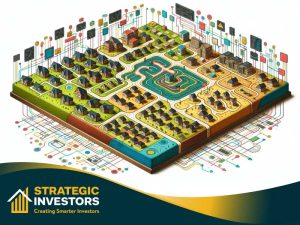
Navigating the maze of property investing strategies can be daunting. Whether you’re a first-time investor or an experienced mogul, understanding which paths lead to profitability is crucial.
This article cuts through the noise, offering a clear breakdown of proven property investing strategies that align with various financial goals.
Without offering an oversimplified solution, we unpack the intricacies of tactics like negative gearing and subdivision development, ensuring you’re equipped with the knowledge to make informed investment decisions in 2024.
Key Takeaways
- Investing in property requires a strategic approach with different methods such as buy-and-hold, positive and negative gearing, and renovation strategies, each having unique benefits, challenges, and suitability depending on an investor’s financial situation and goals.
- Diversifying property investment through subdivisions and developments, using equity smartly, investing in REITs, and ensuring a varied portfolio can mitigate risks and maximize returns, but require an understanding of local laws, thorough research, and careful financial planning.
- Successful property investment hinges on having a competent team, staying informed on market trends, comprehending tax implications, overcoming common challenges with a risk-managed approach, and employing strategic and flexible long-term planning aligned with SMART goals.
Understanding Different Property Investment Strategies

- buy-and-hold
- positive gearing
- negative gearing
- renovation and hold
Now, let’s delve into the specifics of each strategy.
Buy and Hold Strategy
The buy and hold strategy in property investment involves:
- Acquiring property with the intent of retaining it for a long period
- Capitalizing on its potential for value appreciation
- Nurturing a seedling into a full-grown tree
- Investing in a property’s growth potential
- Treating it like a long-term business investment
This strategy is akin to playing the long game in property investment, rather than looking for a quick flip.
However, this strategy is not without its challenges. It requires a considerable time investment before yielding returns due to the reliance on long-term capital growth. Navigating these challenges requires effective financial planning, which covers aspects such as:
- Down payments
- Potential renovation costs
- Tax considerations
- Financing options
Positive Gearing Strategy
Positive gearing is like having a steady river of cash flow. It involves having an income that amounts to more than your expenses from an investment property, which results in taxable income at the investor’s marginal tax rate. This strategy fits well for investors who seek additional cash flow and a lower-risk investment, particularly for first-time investors or those with limited capital.
The benefits of positive gearing extend to improved loan serviceability, faster portfolio growth using extra income for future deposits, and modest profits after taxes, emphasizing additional cash flow. However, investors should look for properties in locations with high rental demand and affordability, but should be aware that these areas may have lower capital growth.
Negative Gearing Strategy
Negative gearing is a strategy that can appear counterintuitive at first glance, but it offers unique advantages. It occurs when an investor borrows money to invest in property, and the rental income received is less than the expenses incurred, allowing the investor to deduct the loss from other taxable income sources. This strategy is often most effective for higher income earners who can gain pronounced tax benefits and those with the financial stability to wait for capital gains upon sale of the property.
Negative gearing does carry potential risks, including cash flow shortfalls and increased expenses due to rising interest rates. However, it also holds the potential for considerable gains if property values appreciate as forecasted. Investors who adopt negative gearing leverage more valuable assets and bank on long-term property appreciation. They must, however, deal with cash flow challenges and the associated liquidity constraints of property investment.
Renovation and Hold Strategy
The ‘renovate and hold’ property investment strategy is all about value addition. It involves purchasing properties, making improvements, and then renting them out for increased rental income. By adding real value to a property, you can command higher rental rates post-renovation and use the increased property equity to further invest.
However, this strategy is not without its hurdles. Investors must be cautious of:
- budget overruns
- unexpected costs which may occur with renovations
- overcapitalizing during renovations
- focusing too greatly on rental yields at the expense of capital growth
These factors can jeopardize profitability.
Property Subdivision and Development

Land Subdivision
Land subdivision opens up a world of possibilities. It involves:
- Dividing a large block of land into smaller parcels to increase equity and potentially yield high returns
- Allowing the development of narrow lots for sale or holding until demand raises their value
- Dramatically increasing profits
Subdividing land also offers multiple income streams, notably renting out all properties to generate cash flow. However, subdivision projects may incur unexpected costs, such as terrain modification and service installation, impacting the budget. Developers, therefore, need to carefully assess the feasibility of subdivisions, keeping in mind local regulations and market demand.
Property Development
Property development is another strategy that can significantly boost your returns. It focuses on new constructions which can result in low maintenance requirements and positive cash flow from the first day of property rental. However, it’s not a walk in the park. It requires dealing with zoning laws and may necessitate changing land use to allow development. Among popular property investment strategies, this one can be quite challenging but rewarding.
Effective risk management in property development entails:
- Collaboration with reputable teams
- Understanding of project-specific risks, such as construction timelines and warranties against defects
- Securing competitive pricing and agreeable deal terms
- Facilitating entry into sought-after markets
- Enabling better financial planning.
Building a Successful Property Investment Team
Property investment is not a solitary pursuit. Assembling a competent property investment team is instrumental in manoeuvring through this intricate domain. This team often includes:
- A real estate attorney for legal support
- A property investment strategist for refining investment strategies and managing your property investment portfolio
- Property management services to handle tenancy issues
Addressing financial hurdles is also vital, with professionals like mortgage brokers assisting investors in managing mortgages during rising interest rates and building a good credit score to secure better financing terms. And when it comes to managing rental properties, investors need to decide if they will undertake the role themselves or hire property managers who can maintain properties, find reliable tenants, and provide 24/7 support.
Monitoring the Property Market
For any property investor, vigilance in monitoring the property market is a must. Success in property investment hinges significantly on keeping abreast of market trends, as it aids investors in gauging market health and making well-informed decisions to safeguard and potentiate their investments.
Keeping track of real estate cycles, monthly property value movements, suburb performance analysis, listings volumes, auction clearance rates, and volume of sales are all critical market performance metrics for evaluating property market conditions. Understanding demographic trends, such as population growth and migration, are also integral to informed market analysis.
Overcoming Common Property Investment Challenges
Investing in property is not without its challenges, particularly in property development and subdivisions. These often face increased lead times due to the intricate process involved. Objections from local communities can add time and complexity to the subdivision process.
Every delay in a property development project can increase the overall costs, impacting the projected profitability. But by accounting for potential delays and increased costs in their initial project plans, investors can better manage the risks associated with property development and subdivision.
Long-Term Property Investment Planning
A successful investment journey is not a sprint; it’s a marathon. Creating a solid long-term property investment plan is anchored on establishing specific, measurable, achievable, relevant, and time-bound (SMART) goals that align with personal risk tolerance and financial objectives. An effective long-term investment strategy in real estate should be periodically reviewed and adjusted to reflect evolving goals and market dynamics.
Being cognizant of and planning for property cycles’ impacts, along with readiness to adapt to shifts in interest rates, regulations, and economic conditions, are vital for sustaining a solid long-term property investment strategy. Consulting with professional advisors can provide critical insights and guidance for refining a property investment strategy over the long term.
Building a Successful Property Investment Team
Property investment is not a solitary pursuit. Assembling a competent property investment team is instrumental in manoeuvring through this intricate domain. This team often includes:
- A real estate attorney for legal support
- A property investment strategist for refining investment strategies and managing your property investment portfolio
- Property management services to handle tenancy issues
Addressing financial hurdles is also vital, with professionals like mortgage brokers assisting investors in managing mortgages during rising interest rates and building a good credit score to secure better financing terms. And when it comes to managing rental properties, investors need to decide if they will undertake the role themselves or hire property managers who can maintain properties, find reliable tenants, and provide 24/7 support.
Monitoring the Property Market
For any property investor, vigilance in monitoring the property market is a must. Success in property investment hinges significantly on keeping abreast of market trends, as it aids investors in gauging market health and making well-informed decisions to safeguard and potentiate their investments.
Keeping track of real estate cycles, monthly property value movements, suburb performance analysis, listings volumes, auction clearance rates, and volume of sales are all critical market performance metrics for evaluating property market conditions. Understanding demographic trends, such as population growth and migration, are also integral to informed market analysis.
Overcoming Common Property Investment Challenges
Investing in property is not without its challenges, particularly in property development and subdivisions. These often face increased lead times due to the intricate process involved. Objections from local communities can add time and complexity to the subdivision process.
Every delay in a property development project can increase the overall costs, impacting the projected profitability. But by accounting for potential delays and increased costs in their initial project plans, investors can better manage the risks associated with property development and subdivision.
Long-Term Property Investment Planning
A successful investment journey is not a sprint; it’s a marathon. Creating a solid long-term property investment plan is anchored on establishing specific, measurable, achievable, relevant, and time-bound (SMART) goals that align with personal risk tolerance and financial objectives. An effective long-term investment strategy in real estate should be periodically reviewed and adjusted to reflect evolving goals and market dynamics.
Being cognizant of and planning for property cycles’ impacts, along with readiness to adapt to shifts in interest rates, regulations, and economic conditions, are vital for sustaining a solid long-term property investment strategy. Consulting with professional advisors can provide critical insights and guidance for refining a property investment strategy over the long term.
Summary
Navigating the property market can seem like a complex maze, but with the right knowledge and strategies, it becomes a path paved with potential profits and financial stability. By understanding various investment strategies, utilizing equity, diversifying your portfolio, keeping tabs on market trends, and building a reliable team, you can maximize your returns in 2024 and beyond. It’s time to turn your property investment dreams into reality.
Frequently Asked Questions














